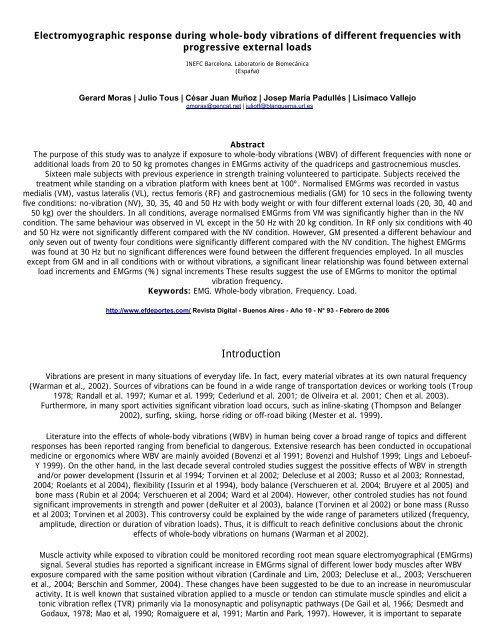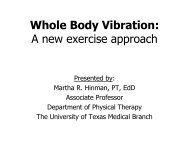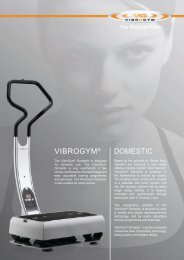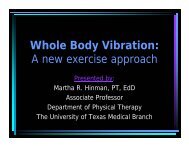Electromyographic response during whole-body vibrations of ...
Electromyographic response during whole-body vibrations of ...
Electromyographic response during whole-body vibrations of ...
Create successful ePaper yourself
Turn your PDF publications into a flip-book with our unique Google optimized e-Paper software.
<strong>Electromyographic</strong> <strong>response</strong> <strong>during</strong> <strong>whole</strong>-<strong>body</strong> <strong>vibrations</strong> <strong>of</strong> different frequencies withprogressive external loadsINEFC Barcelona. Laboratorio de Biomecánica(España)Gerard Moras | Julio Tous | César Juan Muñoz | Josep María Padullés | Lisímaco Vallejogmoras@gencat.net | juliotf@blanquerna.url.esAbstractThe purpose <strong>of</strong> this study was to analyze if exposure to <strong>whole</strong>-<strong>body</strong> <strong>vibrations</strong> (WBV) <strong>of</strong> different frequencies with none oradditional loads from 20 to 50 kg promotes changes in EMGrms activity <strong>of</strong> the quadriceps and gastrocnemious muscles.Sixteen male subjects with previous experience in strength training volunteered to participate. Subjects received thetreatment while standing on a vibration platform with knees bent at 100º. Normalised EMGrms was recorded in vastusmedialis (VM), vastus lateralis (VL), rectus femoris (RF) and gastrocnemious medialis (GM) for 10 secs in the following twentyfive conditions: no-vibration (NV), 30, 35, 40 and 50 Hz with <strong>body</strong> weight or with four different external loads (20, 30, 40 and50 kg) over the shoulders. In all conditions, average normalised EMGrms from VM was significantly higher than in the NVcondition. The same behaviour was observed in VL except in the 50 Hz with 20 kg condition. In RF only six conditions with 40and 50 Hz were not significantly different compared with the NV condition. However, GM presented a different behaviour andonly seven out <strong>of</strong> twenty four conditions were significantly different compared with the NV condition. The highest EMGrmswas found at 30 Hz but no significant differences were found between the different frequencies employed. In all musclesexcept from GM and in all conditions with or without <strong>vibrations</strong>, a significant linear relationship was found between externalload increments and EMGrms (%) signal increments These results suggest the use <strong>of</strong> EMGrms to monitor the optimalvibration frequency.Keywords: EMG. Whole-<strong>body</strong> vibration. Frequency. Load.http://www.efdeportes.com/ Revista Digital - Buenos Aires - Año 10 - N° 93 - Febrero de 2006IntroductionVibrations are present in many situations <strong>of</strong> everyday life. In fact, every material vibrates at its own natural frequency(Warman et al., 2002). Sources <strong>of</strong> <strong>vibrations</strong> can be found in a wide range <strong>of</strong> transportation devices or working tools (Troup1978; Randall et al. 1997; Kumar et al. 1999; Cederlund et al. 2001; de Oliveira et al. 2001; Chen et al. 2003).Furthermore, in many sport activities significant vibration load occurs, such as inline-skating (Thompson and Belanger2002), surfing, skiing, horse riding or <strong>of</strong>f-road biking (Mester et al. 1999).Literature into the effects <strong>of</strong> <strong>whole</strong>-<strong>body</strong> <strong>vibrations</strong> (WBV) in human being cover a broad range <strong>of</strong> topics and different<strong>response</strong>s has been reported ranging from beneficial to dangerous. Extensive research has been conducted in occupationalmedicine or ergonomics where WBV are mainly avoided (Bovenzi et al 1991; Bovenzi and Hulsh<strong>of</strong> 1999; Lings and Leboeuf-Y 1999). On the other hand, in the last decade several controled studies suggest the possitive effects <strong>of</strong> WBV in strengthand/or power development (Issurin et al 1994; Torvinen et al 2002; Delecluse et al 2003; Russo et al 2003; Ronnestad,2004; Roelants et al 2004), flexibility (Issurin et al 1994), <strong>body</strong> balance (Verschueren et al. 2004; Bruyere et al 2005) andbone mass (Rubin et al 2004; Verschueren et al 2004; Ward et al 2004). However, other controled studies has not foundsignificant improvements in strength and power (deRuiter et al 2003), balance (Torvinen et al 2002) or bone mass (Russoet al 2003; Torvinen et al 2003). This controversy could be explained by the wide range <strong>of</strong> parameters utilized (frequency,amplitude, direction or duration <strong>of</strong> vibration loads). Thus, it is difficult to reach definitive conclusions about the chroniceffects <strong>of</strong> <strong>whole</strong>-<strong>body</strong> <strong>vibrations</strong> on humans (Warman et al 2002).Muscle activity while exposed to vibration could be monitored recording root mean square electromyographical (EMGrms)signal. Several studies has reported a significant increase in EMGrms signal <strong>of</strong> different lower <strong>body</strong> muscles after WBVexposure compared with the same position without vibration (Cardinale and Lim, 2003; Delecluse et al., 2003; Verschuerenet al., 2004; Berschin and Sommer, 2004). These changes have been suggested to be due to an increase in neuromuscularactivity. It is well known that sustained vibration applied to a muscle or tendon can stimulate muscle spindles and elicit atonic vibration reflex (TVR) primarily via Ia monosynaptic and polisynaptic pathways (De Gail et al, 1966; Desmedt andGodaux, 1978; Mao et al, 1990; Romaiguere et al, 1991; Martin and Park, 1997). However, it is important to separate
esearch utilising the direct application <strong>of</strong> a vibration signal at the surface <strong>of</strong> the muscle/tendon unit or through WBV.Moreover, specific WBV frequencies seem to produce higher EMGrms signal than others. In this way, Cardinale and Lim(2003) have found that 30 Hz vibration frequency provokes a significant higher <strong>response</strong> than 40 Hz and the lattercompared to 50 Hz.However, in our best knowledge, there are not any studies concerning the effects <strong>of</strong> different external loads andfrequencies on EMGrms <strong>response</strong>. In fact, WBV protocols widely used in sport training or fitness facilities usually include thecombination <strong>of</strong> different external loads and frequencies. Only Rittweger et al (2002) have investigated the effects <strong>of</strong>different frequencies and amplitudes <strong>of</strong> vibration with different external loads on oxygen uptake. Results showed anincrease <strong>of</strong> VO 2 proportional to the frequency increase (18, 26 or 34 Hz). Each vibration cycle evoked an oxygenconsumption <strong>of</strong> approximately 2.5 Ml 2 kg-1 with 5 mm amplitude. Furthermore, VO 2 increased more than proportionallywith amplitudes from 2,5 to 7,5 mm. With an additional load <strong>of</strong> 40% <strong>of</strong> the lean <strong>body</strong> mass attached to the waist, oxygenuptake likewise increased significantly. A further increase was observed when the load was applied to the shoulders.The purpose <strong>of</strong> this study was to analyze normalised EMGrms <strong>response</strong>s in the vastus medialis and lateralis, rectusfemoris and gastrocnemius medialis while standing on a platform vibrating at different frequencies (30, 35, 40 and 50 Hz)with own <strong>body</strong> weight or applying different external loads (20, 30, 40 and 50 kg).MethodsSubjectsSixteen male subjects with previous experience in weight training but not necessarely in WBV training, volunteered toparticipate in the study after giving their informed consent. Subjects were well trained and usually perform weight trainingat least twice a week. The mean (SD) age, weight, height and half-squat 1RM were: 23 (2.1) years, 74.4 (6.5) kg, 172.4(5.3) cm and 163 (37.7) kg respectively.EMG analysisOnline EMGrms data was collected using the Musclelab 4000e (Ergotest Technology; Langesund, Norway) recording andacquisition system, employing the accompanying 7.16 s<strong>of</strong>tware version on a laptop computer. This device converts theamplified EMG raw signal to an average root mean square signal (100 Hz, sampling <strong>of</strong> converted signal) via its built-inhardware circuit network.The signals <strong>of</strong> vastus lateralis and medialis, rectus femoris and gastrocnemius medialis were recorded with bipolarsurface electrodes (Blue Sensor, Medicotest, Olstykke, Denmark) fixed longitudinally to the muscle belly in the dominantleg. Skin was shaved (if necessary) and cleaned with an alcohol wrap until ruborization following Cram and Kasman (1998)guidelines. First, subjects performed two maximal voluntary isometric contractions (MVC) over 5 seconds on the platformwith 100º knee flexion while holding two nylon straps (see figure 1). In case data differed more than 10% between trials athird trial was allowed. Both arbitrary (mV) and normalised (%) data were recorded.
Figure 1. Normalization procedure <strong>of</strong> EMGrms signal performed over the vibration platform.Vibration procedureBefore exposure to vibration subjects performed a 3 min warm-up on an ergometer (70 RPM and 75 W).Subjects were exposed to a vertical sinusoidal vibration with a Power PlateÒ platform. Vibration amplitude was heldconstant at 4mm. While mantaining the squat position (with 100º flexion) <strong>during</strong> ten seconds, EMGrms was recorded in thetwenty-five following conditions: no-vibration, vibration at 30, 35, 40 and 50 Hz with no external load or with 20, 30, 40 and50 kg added. External resistance was accomplished by use <strong>of</strong> an Olympic barbell that was placed behind the neck and overthe shoulders. To avoid fatigue enough recovery was allowed between conditions. To minimize fatigue-related effects, theorder in which all vibration conditions were presented was randomized. Body position was monitored using a linear encoderattached to the hip.Data analysisThe EMGrms signal was recorded over 10 sec in each condition. In case any artifact was present in the signal thecondition was repeated again.Statistical analysesA repeated-measures ANOVA with contrasts was used to compare the average EMGrms <strong>of</strong> different muscles in alltwenty-five conditions. The level <strong>of</strong> statistical significance was set at p£0.05.ResultsAfter comparing each condition with or without vibration treatment the first provoked a higher normalised EMGrmsactivity <strong>of</strong> the three quadriceps muscles studied. This higher <strong>response</strong> was statistically significant in all cases except inrectus femoris (between NV and 40, 50 Hz with <strong>body</strong> weight (BW), 20 and 30 kg conditions) and vastus lateralis (betweenNV and 50 Hz with 20 kg condition). On the other hand, GM presents a different behaviour and significant differences wereonly found in the following conditions: between NV and 30 Hz with BW; NV and 35 Hz with 50 kg; NV and 40 Hz with 20,30, 40 and 50 kg and between NV and 50 Hz with 50 kg. Table 1 and figures 2 to 5 shows average EMGrms (%) and SDfrom the selected muscle portions.
With BW the highest EMGrms (%) activity was found at 30 Hz in all muscles. VM and VL present the highest differencebetween NV and all vibration conditions with 30 Hz and BW (+47% and +87% respectively) but RF with 30 Hz and 20 kg(+66%) and GM with 30 Hz and 30 kg. However, when increasing the load (30, 40 and 50 kg) RF and VM present a higheractivity with higher frequencies (35 Hz with 30 and 40 kg and 40 Hz with 50 Kg in RF; and 35 Hz with 30 kg and 40 Hz with40 and 50 kg in VM) however, these differences are not significant. Only two <strong>of</strong> the contrasts between different frequenciesare significant: with 30 Hz and 20 kgs condition, RF presents significant higher activity in comparison with 50 Hz and 20 kgcondition; with 40 Hz and 40 kg condition, VM presents significant higher activity than 50 Hz and 40 kg condition.In all three quadriceps muscle portions and all vibration frequencies studied a significant linear relationship was observedbetween EMGrms (%) activity and load increases. However, this was not the case for GM which presents a heterogeneous<strong>response</strong>.Table 1. Normalised EMGrms activity <strong>of</strong> each muscle portion in no-vibration (NV)condition or exposed to different <strong>vibrations</strong> frequencies with own <strong>body</strong> weight (BW) or different external loads.
Figure 2. Normalised EMGrms activity <strong>of</strong> vastus lateralis, vastus medialis, rectus femoris and gastrocnemius medialis in no-vibration (NV) condition or exposed todifferent <strong>vibrations</strong> frequencies with own <strong>body</strong> weight (BW) or different external loads (see significant differences in table 1).DiscussionBased on the results obtained, it was posible to verify that WBV at 30 Hz transmitted through a vibration platform in halfsquat position without any additional load significantly increased the normalised EMGrms activity <strong>of</strong> all muscle portionsstudied compared with the nonvibrating condition. To the best <strong>of</strong> our knowledge this is the first study that collectednormalised EMGrms activity <strong>during</strong> application <strong>of</strong> a WBV stimulus from a commercially available platform in four lower <strong>body</strong>muscles.Despite electromyographic <strong>response</strong> was highly variable between different subjects, specific vibration frequencies mayproduce higher normalised EMGrms values than others. This behaviour was expected and in agreement with a previousstudy (Cardinale and Lim 2003). However, in our study no significant differences were found when comparing 30, 35, 40and 50 Hz in mainly all conditions. A quadratic relationship was observed between frequency increments and EMGrms signalincrements in all muscles. The higher <strong>response</strong> under specific frequencies may depend on the position to be held. In theselected half squat position significant differences were found in vastus medialis and lateralis activity between no-vibrationcondition with all frequencies and mainly all external load conditions. However, rectus femoris and gastrocnemius medialis,both biarticular muscles, do not respond in the same way to all frequencies and external load conditions, being thesignificant differences less frequent in GM. A higher EMGrms <strong>response</strong> in RF and GM could be likely obtained if selectedposition <strong>during</strong> vibration exposure submits the muscle to an active or passive tension. Just by performing, from a half squatposition, a slight hip extension, a heel raise or by an activation <strong>of</strong> these muscles a considerable increase in EMG activity wasobserved (data not presented).Cardinale and Lim (2003) in their study, reported the highest EMGrms at 30-Hz (+34% in comparison with NV,p
stiffness <strong>of</strong> the musculoskeletal system and could explain this changes in EMG activity. In fact, Cardinale and Lim (2003)suggest that vibration causes a strong perturbation that is perceived by the central nervous system which modulates thestifness <strong>of</strong> the stimulated muscle groups. The reflex activity could be responsible for the minimization <strong>of</strong> vibration over s<strong>of</strong>ttissues as proposed by Wakeling et al (2002). This <strong>response</strong> may be a complex interaction between mechanical and reflexfactors and could not be the same under different external load conditions and different subjects. It could be speculatedthat, in subjects with higher stiffness, the maximum EMGrms <strong>response</strong> could be found under higher vibration frequencies,but further studies are needed to clarify this <strong>response</strong>.In all conditions a significant linear relationship (p
• Desmedt JE, Godaux E (1978) Mechanism <strong>of</strong> the vibration paradox: excitatory and inhibitory effects <strong>of</strong> tendonvibration on single soleus muscle motor units in man. J Physiol 285: 197-207• Humphries B, Warman G, Purton J, Doyle TL, Dugan E (2004) The influence <strong>of</strong> muscle activation and rate <strong>of</strong> forcedevelopment <strong>during</strong> maximal isometric contractions. J Sports Sci Med 3: 16-22• Issurin VB, Liebermann DG, Tenenbaum G (1994) Effect <strong>of</strong> vibratory stimulation training on maximal force andflexibility. J Sports Sci 12: 561-6• Kumar A, Varghese M, Mohan D, Mahajan P, Gulati P, Kale S (1999) Effect <strong>of</strong> <strong>whole</strong>-<strong>body</strong> vibration on the low back.A study <strong>of</strong> tractor-driving farmers in North India. Spine 24: 2506-2515• Lings S, Leboeuf-Yde C (2000) Whole-<strong>body</strong> vibration and low back pain: a systematic, critical review <strong>of</strong> theepidemiological literature 1992-1999. Int Arch Occup Environ Health 73: 290-7• Mao CC, McGill KC, Dorfman LJ (1990) Muscle vibration facilitates orderly recruitment <strong>of</strong> motor units. ElectromiogrClin Neurophysiol 30: 245-252• Martin BJ, Park HS (1997) Analysis <strong>of</strong> the tonic vibration reflex: influence <strong>of</strong> vibration variables on motor unitsynchronization and fatigue. Eur J Appl Physiol Occup Physiol 75: 504-11• Mester J, Spitzenfeil P, Schwarzer J, Seifriz F (1999) Biological reaction to vibration--implications for sport. J Sci MedSport 2: 211-26• Randall JM, Matthews RT, Stiles MA (1997) Resonant frequencies <strong>of</strong> standing humans. Ergonomics 40:• Rittweger J, Ehrig J, Just K, Mutschelknauss M, Kirsch KA, Felsenberg D (2002) Oxygen uptake in <strong>whole</strong>-<strong>body</strong>vibration exercise: influence <strong>of</strong> vibration frequency, amplitude, and external load. Int J Sports Med 23: 428-32• Roelants M, Delecluse C, Goris M, Verschueren S (2004) Effects <strong>of</strong> 24 weeks <strong>of</strong> <strong>whole</strong> <strong>body</strong> vibration training on<strong>body</strong> composition and muscle strength in untrained females. Int J Sports Med 25: 1-5• Romaiguere P , Vedel JP, Azulay JP, Pagni S (1991) Diferential activation <strong>of</strong> motor units in the wrist extensormuscles <strong>during</strong> the tonic vibration re.ex in man. J Physiol 444: 645-667• Ronnestad BR (2004) Comparing the performance-enhancing effects <strong>of</strong> squats on a vibration platform withconventional squats in recreationally resistance-trained men. J Strength Cond Res 18: 839-45• Rubin C, Recker R, Cullen D, Ryaby J, McCabe J, McLeod K (2004) Prevention <strong>of</strong> postmenopausal bone loss by alow-magnitude, high-frequency mechanical stimuli: a clinical trial assessing compliance, efficacy, and safety. J BoneMiner Res 19: 343-51• Russo CR, Lauretani F, Bandinelli S, Bartali B, Cavazzini C, Guralnik JM, Ferrucci L (2003) High-frequency vibrationtraining increases muscle power in postmenopausal women. Arch Phys Med Rehabil 84 : 1854-1857• Thompson C, Belanger M (2002) Effects <strong>of</strong> vibration in inline skating on the H<strong>of</strong>fmann reflex, force, andproprioception. Med Sci Sports Exerc 34: 2037-44• Torvinen S, Kannus P, Sievanen H, Jarvinen TA, Pasanen M, Kontulainen S, Jarvinen TL, Jarvinen M, Oja P, Vuori I(2002) Effect <strong>of</strong> four-month vertical <strong>whole</strong> <strong>body</strong> vibration on performance and balance. Med Sci Sports Exerc 34:1523-8• Torvinen S, Kannus P, Sievanen H, Jarvinen TA, Pasanen M, Kontulainen S, Nenonen A, Jarvinen TL, Paakkala T,Jarvinen M, Vuori I (2003) Effect <strong>of</strong> 8-month vertical <strong>whole</strong> <strong>body</strong> vibration on bone, muscle performance, and <strong>body</strong>balance: a randomized controlled study. J Bone Miner Res 18: 876-84• Troup J (1978) Driver's back pain and its prevention: A review <strong>of</strong> postural, vibratory and muscular factors togetherwith problem <strong>of</strong> transmitted road-shock. Appl Ergon 9: 207-214• Verschueren SM, Roelants M, Delecluse C, Swinnen S, Vanderschueren D, Boonen S (2004) Effect <strong>of</strong> 6-month <strong>whole</strong><strong>body</strong> vibration training on hip density, muscle strength, and postural control in postmenopausal women: arandomized controlled pilot study. J Bone Miner Res 19: 352-9• Wakeling JM, Nigg BM, Rozitis AI (2002) Muscle activity damps the s<strong>of</strong>t-tissue resonance which occurs in <strong>response</strong>to pulsed and continuous <strong>vibrations</strong>. J Appl Physiol 93: 1092-1103• Ward K, Alsop C, Caulton J, Rubin C, Adams J, Mughal Z (2004) Low magnitude mechanical loading is osteogenic inchildren with dissabilities conditions. J Bone Miner Res 19: 360-9• Warman G, Humprhries B, Purton P (2002) The effects <strong>of</strong> timing and aplication <strong>of</strong> vibration on muscularcontractions. Aviat Space Environ Med 73: 119-127






